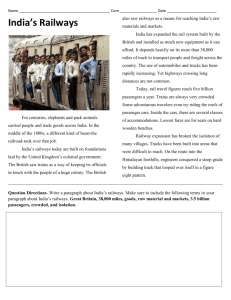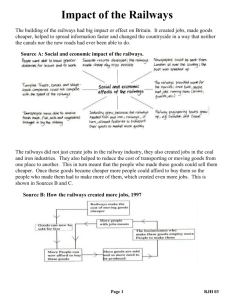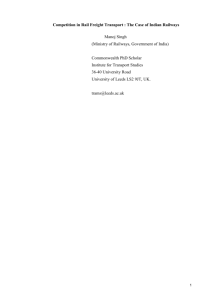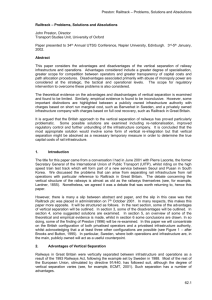REVIEW FOR `TRANSPORT ECONOMIST MARTIN HIGGINSON
advertisement
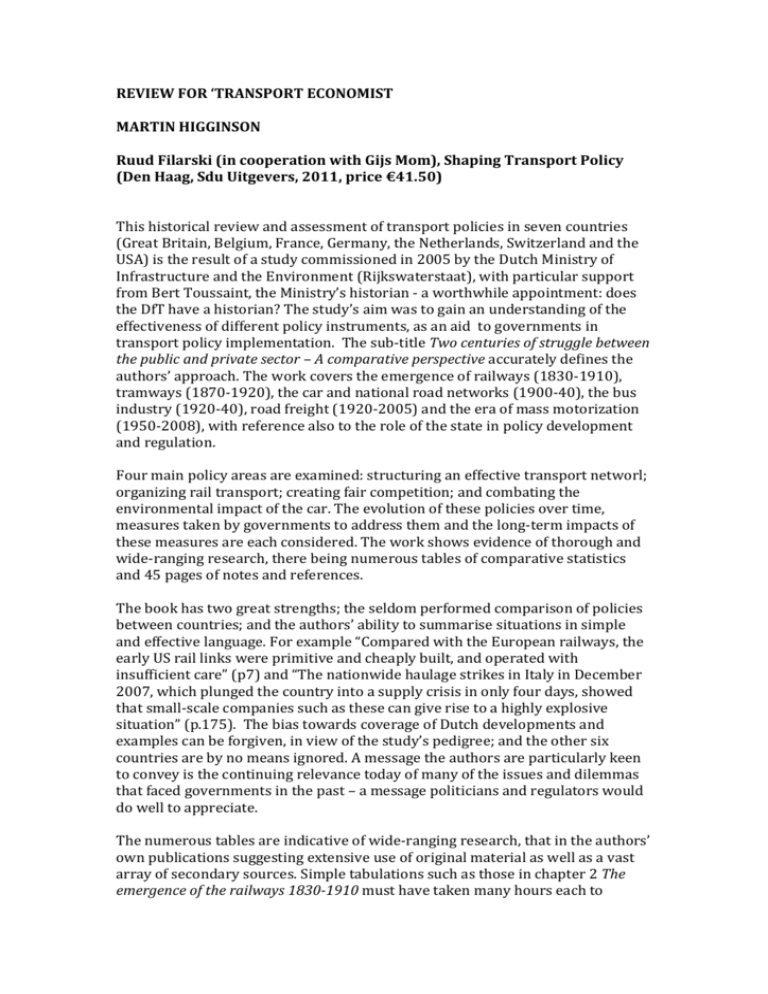
REVIEW FOR ‘TRANSPORT ECONOMIST MARTIN HIGGINSON Ruud Filarski (in cooperation with Gijs Mom), Shaping Transport Policy (Den Haag, Sdu Uitgevers, 2011, price €41.50) This historical review and assessment of transport policies in seven countries (Great Britain, Belgium, France, Germany, the Netherlands, Switzerland and the USA) is the result of a study commissioned in 2005 by the Dutch Ministry of Infrastructure and the Environment (Rijkswaterstaat), with particular support from Bert Toussaint, the Ministry’s historian - a worthwhile appointment: does the DfT have a historian? The study’s aim was to gain an understanding of the effectiveness of different policy instruments, as an aid to governments in transport policy implementation. The sub-title Two centuries of struggle between the public and private sector – A comparative perspective accurately defines the authors’ approach. The work covers the emergence of railways (1830-1910), tramways (1870-1920), the car and national road networks (1900-40), the bus industry (1920-40), road freight (1920-2005) and the era of mass motorization (1950-2008), with reference also to the role of the state in policy development and regulation. Four main policy areas are examined: structuring an effective transport networl; organizing rail transport; creating fair competition; and combating the environmental impact of the car. The evolution of these policies over time, measures taken by governments to address them and the long-term impacts of these measures are each considered. The work shows evidence of thorough and wide-ranging research, there being numerous tables of comparative statistics and 45 pages of notes and references. The book has two great strengths; the seldom performed comparison of policies between countries; and the authors’ ability to summarise situations in simple and effective language. For example “Compared with the European railways, the early US rail links were primitive and cheaply built, and operated with insufficient care” (p7) and “The nationwide haulage strikes in Italy in December 2007, which plunged the country into a supply crisis in only four days, showed that small-scale companies such as these can give rise to a highly explosive situation” (p.175). The bias towards coverage of Dutch developments and examples can be forgiven, in view of the study’s pedigree; and the other six countries are by no means ignored. A message the authors are particularly keen to convey is the continuing relevance today of many of the issues and dilemmas that faced governments in the past – a message politicians and regulators would do well to appreciate. The numerous tables are indicative of wide-ranging research, that in the authors’ own publications suggesting extensive use of original material as well as a vast array of secondary sources. Simple tabulations such as those in chapter 2 The emergence of the railways 1830-1910 must have taken many hours each to compile. Lengths of line, related to populations and land surface areas, and average fares show how the railway revolution started in Britain, and the United States, with other nations soon catching up and overtaking. Belgium, France, Germany, the Netherlands and, in particular Switzerland, with only 25 route km, all lagged behind Britain 9,800 km and the USA (14,500) in 1850. By 1880 the scale of the French and German networks approximately equaled Britain’s and that of the USA was six times larger. The Swiss network had grown to 2,500 km. The complaint of high rail fares in Britain is nothing new; in 1850 they were already some 50% higher than the average in the other countries in the sample, and remained constant whilst those in other countries declined. While many readers will be reasonably familiar with the situation in their own country, the parallel presentation of international evidence will be revealing. It is therefore of particular interest that the authors have been able to discuss a series of key questions that apply across the board (p204). Should governments be responsible for establishing coherent rail and road networks, or the task left to regional/local authorities, or to market forces? To what extent should railways be regulated by governments? Should governments intervene to establish equal competitive conditions, or to promote particular modes? And a question that has risen up the ranks of importance in recent years: to what extent should governments intervene to reduce the environmental impacts of transport, especially of cars? In their conclusions the authors remind the reader of the study’s principal purpose; to advise and inform policy-makers on any lessons to be taken forward from past experience and set out three propositions: that policymakers need to develop and nurture a thorough understanding of traffic and transport; that they must be in a position to apply this knowledge in an unprejudiced manner; and that transport policies can only be effective if supported by society at large – so policymakers must work closely with the general public, with the business community and with critics. Your reviewer has no hesitation in recommending this work to transport economists as a comprehensive, balanced, well presented, informative and eminently readable contribution to the literature on transport policy. Martin Higginson Transport Research & Consultancy 19 October 2011

